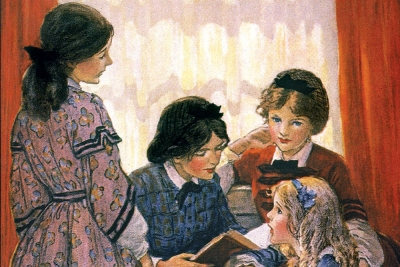
Louisa May Alcott’s Little Women is a semi-autobiographical American coming-of-age story about four sisters. A critique of the unrealistic perception of blissful female domesticity, this novel has never once been out of print since it was first published in 1868, and has even been adapted for the big screen seven times to date. Let’s revisit the classic and look at what makes it relevant even today.
About the author
Louisa May Alcott was the second of four daughters born to Amos Bronson Alcott and Abigail May on November 29, 1839. Her father was an autodidact, which means he taught himself how to read and write. He eventually became a progressive educator and founded the temple school, where he introduced subjects such as art music nature studies, and physical education into the curriculum, in the hope of providing holistic education to the students. However, the school was shut down as most parents at the time were neither familiar nor happy with these subjects. Bronson Alcott’s unconventional teaching methods were the reasons why he could never establish a steady source of income and brought his family to the verge of poverty.
Growing up, Louisa’s way of thinking was not only shaped by her father’s teaching but also by close interactions with his friends, American authors Ralph Waldo Emerson and Henry David Thoreau, whom the family befriended upon moving to Concord.
Distressed by her family’s financial status, 15-year-old Louisa wrote in her diary “I will do something by and by. Don’t care what, teach, sew, act, write anything to help the family and I’ll be rich and famous and happy before I die, see if I won’t. And she was able to fulfil this, thanks to the massive success of her semi-autobiographical novel Little Women, which was initially published in two parts Little Women (1868) and The Good Wives (1869).
Fortunate accidents
Louisa May Alcott never wanted to write Little Women, as it went against all of her impulses to be taken seriously as a writer and an equal to her male contemporaries but ended up penning the iconic story as a consequence of a series of fortunate accidents.
She was 36 years old and had already published a few books under the pen name A.M. Barnard when her publisher Thomas Niles insisted that her next novel should be about the domestic sphere and cater to young women. Enticing her further, Niles suggested that he would willingly Mr Alcott’s philosophy book too if Louisa agreed to this.
Just for the sake of her father, she agreed and wrote what would become her most celebrated book in a 10-week flurry, drawing from her own childhood experiences.
Little Women
The novel chronicles the lives of the Four March sisters: Meg, Jo, Beth, and Amy as they grow up during the American Civil War, wrestling with the limitations placed on women in the 19th Century. It critiques how women are forced to make cruelly imposed compromises between self-fulfilment and economic and social necessity.
What makes it a classic?
The blueprint of a family
This work of children’s fiction has a didactic tone that sets it apart from most of the literature that appeared before it. Louisa’s realistic characters and sentimental themes explore how social reform must start at home. Little Women functions as a blueprint of what it takes to have a healthy relationship with your family. Although the story is set in the tumultuous background of the civil war and the scarlet fever outbreak, the connection that the flawed and vulnerable March sisters have and share with the people that surround them is what makes them more life-like, relatable, and relevant. The book celebrates their diverse takes on difficult situations, individual struggles with poverty, and different aspirations in life, highlighting how no two individuals can be the same even if they are raised under the same roof with the same resources.
The matriarch
Through the strong and self-reliant character of Marmee, the author challenges the prevailing assumptions of 19th Century society that saw women as domestic goddesses that were best kept indoors tending to every need of the family.
Marmee is a source of awe and inspiration to her children, who have witnessed her single-handedly manage the household and make a living while their father is away at war. Her unconventional way of thinking, which suggests self-respect, peace, and true love must hold more importance than money and even marriage, motivates her daughters to dream big and accomplish more in their lives.
Picture Credit : Google



